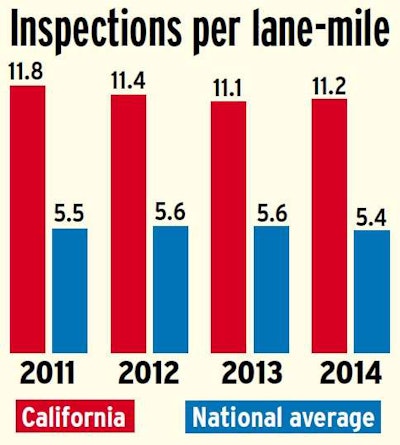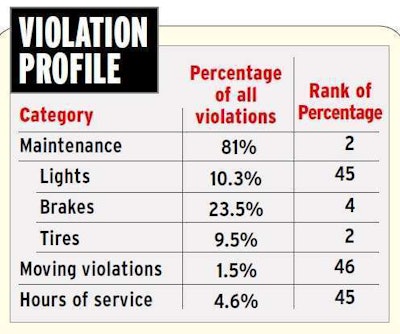
Last year, Swift-leased owner-operator John Raffone was on a run west across Interstate 10 that ultimately would take him to California’s notorious Banning scale. His 2013 Kenworth was pulling an older company van that showed its age.
When Raffone got to Phoenix, Swift’s headquarters city, he stopped off for a preventive maintenance inspection at the main terminal. It’d been some time since the last one, he knew from the trailer’s papers.
Call it preparation, Raffone says, for what is perennially a contender for the top spot in Overdrive’s CSA’s Data Trail inspection-intensity rankings. California sits at No. 2 again with this year’s update, after falling to No. 3 as Pennsylvania climbed the rankings last year. But there’s a difference between California and the next-closest two states of Maryland and Pennsylvania, and that’s geography.

The Golden State comprises large swathes of land with low population density – “we’ve got deserts,” says California Highway Patrol Lt. James Portilla, with the Commercial Vehicle Section – as well as some of the most densely populated parts of the country. That’s all spread out over an area second in size only to Texas in the continental United States, with a boatload of National Highway System lane-miles in its borders.

California’s inspection-intensity measure remains high – 11 inspections per lane-mile in the 2014 update – and that’s no surprise to longtime truckers. The state, as Raffone’s anecdote attests, is one that warrants preparation in terms of inspections. It operates 51 fixed weigh and inspection stations statewide, with a large new one near the Nevada line on I-15 expected to open in September, Portilla says. While some states have no scales open in the wee hours, he estimates slightly more than half of California’s facilities are open 24/7.

Portilla and Sgt. Josh Clements, both working primarily out of CHP’s Sacramento headquarters, are two of the nearly 1,000 inspectors involved in the program. Among them, 429 are officers certified for Level 1, hazmat and cargo tank inspections, and 137 of those are mobile, Clements says. “The rest are assigned to the facilities.”
Another 247 civilian inspectors, Level 1 and hazmat-certified, also work the facilities. The 250-or-so balance is made up of inspectors who attend to the state’s terminal inspection program, requiring a visit to every registered motor carrier every two years.
There is more that sets California apart from every other top 10 state for inspection intensity. For one, it’s the only one among that group that logs more than 50 percent of inspections without a single violation. Its violations-per-inspection measure for 2014 was only 0.9. In that distinction, California joins just six other states for the lowest intensity of violations issued.
 California and Texas together account for more than a quarter of all inspections performed in the continental United States. But unlike Texas and many other states, California’s number of total issued violations actually was smaller than its total number of inspections in 2014. California is also one of seven states whose propensity for issuing clean inspections is also high. Click through the image or follow this link for the rest of truckers’ most favorable states for clean inspections. The state’s reputation as being tough on truckers, however, continues with its No. 2 position in the inspection intensity rankings and active weigh-station inspection program. The state in 2014 was more likely to delay drivers for vehicle and credentials checks than any state other than Maryland, and it’s perennially near the top of Overdrive’s CSA’s Data Trail inspection-intensity rankings.
California and Texas together account for more than a quarter of all inspections performed in the continental United States. But unlike Texas and many other states, California’s number of total issued violations actually was smaller than its total number of inspections in 2014. California is also one of seven states whose propensity for issuing clean inspections is also high. Click through the image or follow this link for the rest of truckers’ most favorable states for clean inspections. The state’s reputation as being tough on truckers, however, continues with its No. 2 position in the inspection intensity rankings and active weigh-station inspection program. The state in 2014 was more likely to delay drivers for vehicle and credentials checks than any state other than Maryland, and it’s perennially near the top of Overdrive’s CSA’s Data Trail inspection-intensity rankings.It’s unlikely any trucker would call California’s truck-enforcement division the “trucker’s best friend,” but a by-the-numbers look suggests it. Clements concurs to an extent: “I don’t know that ‘best friend’ is the way I would necessarily describe us. But if [a trucker’s] in a vehicle that’s in compliance, we’re not afraid of putting a sticker on there.”
Both Clements and Portilla see a few other things at work behind the numbers, namely the state’s reputation and active fixed-facility program (accounting for a full two-thirds of all its inspections). The California Air Resources Board’s in-use diesel regulations also mean that older equipment is virtually banned from the roads, says Clements. The active fleet there by and large is newer than anywhere else in the country, with less exposure to an opportunity for problems.
“We expect our inspectors to do inspections,” says Portilla, underlining an enforcement philosophy that expects, and rewards, compliance rather than emphasizing violation quotas and the like. From a managerial perspective, officers “are treated the same during employee evaluations whether they give us a clean inspection or one with violations,” he says.
Local haulers “know that if they have a current CVSA sticker, they have less of a chance of being inspected,” Portilla says. “A driver can go into any of our facilities and request an inspection, and if we’re not particularly busy, we’ll do it. There are so many places available to be inspected when drivers know they’re clean.”
Raffone says when he approached the Banning scale with the not-so-pristine company trailer in tow, the look in the officer’s eye was priceless. “Easy violations,” Raffone figured the officer was thinking. But after Raffone’s bit of PM in Phoenix, the trucker, his truck and the trailer passed with flying colors. He left with a new sticker.
SOURCE FOR ALL DATA WITH THIS STORY: Calendar year 2014 federal data mined by RigDig Business Intelligence (rigdig.com/bi, 866-237-7788). Rankings exclude Alaska, Hawaii and the District of Columbia.











